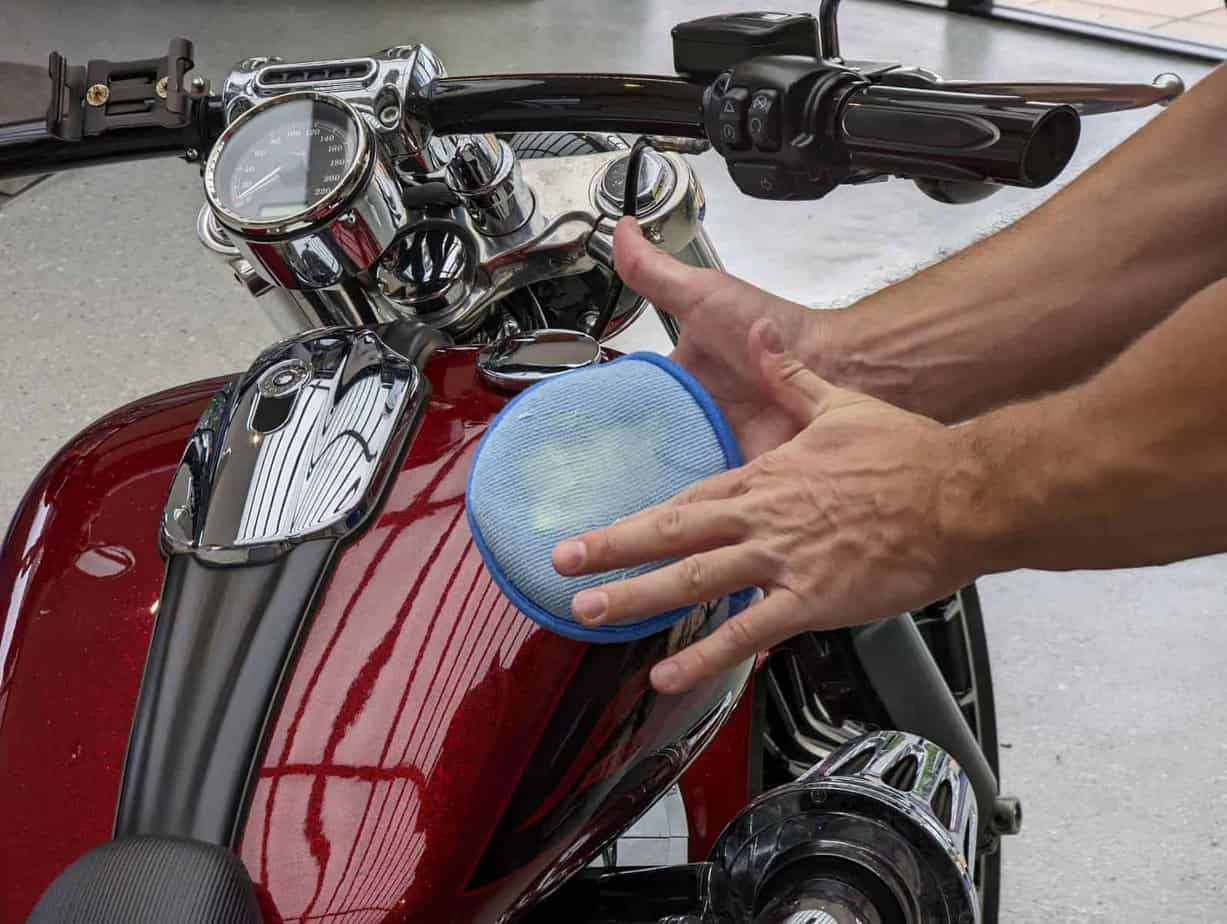Repainting a motorcycle helmet can be a fantastic way to personalize your gear and make a bold statement on the road. However, achieving a professional-looking repaint job requires careful preparation and execution.
You can easily repaint a motorcycle helmet and give it a personalized touch by following these simple steps:
- Plan your design
- Disassemble and Clean your helmet
- Sand it with 200 grit, then 400 grit wet sandpaper and clean it
- Apply a coat of primer and let it dry
- Sand again with 400 grit wet sandpaper and clean it again
- Apply your paint and let it dry
- Apply two coats of clear
- Light sand with 400 grit, then 800 grit wet sandpaper and clean
- Apply a last coat of clear
With the right tools and techniques, your helmet can become a unique work of art on the road. This guide will explore the essential tools and materials you’ll need and provide a step-by-step process to help you transform your helmet.
Essential Tools and Materials to Repaint Your Motorcycle Helmet
To kick-start your helmet painting project, ingathering necessary tools and materials. is important. Here’s a list of essential items you’ll need:
- Safety Gear:
-Safety goggles or glasses to protect your eyes from paint particles and fumes.
-Disposable gloves to keep your hands clean and shielded from harmful chemicals. - Helmet Preparation Supplies:
-Fine-grit wet sandpaper (220, 400 and 800 grit) or sanding sponge for smoothing the helmet’s surface.
– A degreasing agent or mild soap and water to clean the helmet and remove dirt or oils.
– Masking tape and plastic sheets to cover areas you don’t want to paint. - Paint and Primer:
– Helmet-specific paint primer designed to enhance adhesion and durability.
– High-quality acrylic or enamel paints in your desired colours.
– Clear coat for a glossy finish and to protect the paint from scratches. - Painting Tools:
– Various paintbrushes for detailed work.
– Airbrush or spray gun for more extensive coverage.
– Paint palette or mixing cups for blending colours.

How to Prep a Motorcycle Helmet for repainting
Before diving into the painting process, proper helmet preparation is vital. Follow these steps:
- Clean the Helmet:
Start by thoroughly cleaning the helmet’s surface with a mild soap and water solution or a suitable degreasing agent. Ensure that all dirt, dust, and oils are removed. Rinse and allow the helmet to dry completely. Check our guide here if you need more information on cleaning your helmet. - Disassemble the helmet:
Ensure you disassemble all the parts you don’t want to paint, like plastics and foam inserts. - Pre-sanding:
Use fine-grit sandpaper (200 grit) or a sanding sponge to sand the helmet’s surface gently. Take care not to rub too aggressively and damage the helmet’s integrity. - Sanding again:
…I know it’s not fun, but this time, with 400 grit, get rid of any lines you make with the 220 grit sandpaper. This step helps to create a rough texture, allowing the primer to adhere better. - Masking:
Protect any areas you don’t want to paint by applying masking tape and covering them with plastic sheets. This will help you achieve clean lines and avoid accidental paint overspray.
An Easy-to-Follow Repainting Step-by-Step Process
Planning Your Design
Before diving into the painting process, planning your design is essential. Consider the colours, patterns, and elements you want to incorporate into your helmet. Sketching your design on paper or using digital tools can help visualize the final result and adjust as needed.
Applying Primer for Best Results
Priming is a crucial step in achieving a professional paint job. Apply a thin, even coat of helmet-specific primer using a paintbrush or spray gun. The primer enhances adhesion and provides a smooth base for the subsequent layers of paint. Follow the manufacturer’s instructions for drying times between coats.
After the primer is completely dry (it can take hours to several days), you need to sand it again…This time, use only 400 grit and rub it lightly. Use a clean, damp rag to clean the helmet again.
Which Paint To Use and Applying the Paint
Choose high-quality acrylic or enamel paints designed explicitly for helmets. These paints offer durability and resistance to weather conditions.
Apply the paint in thin, even coats, gradually building the colour. Use a paintbrush, airbrush, or spray gun, depending on your preferred technique and the complexity of your design. Allow each coat to dry before applying additional layers.
Adding a Clear Coat for Protection and Shine
Once you’re satisfied with the colour and coverage and your paint is completely dry, apply a clear coat (Coat One) to protect the paint and add a glossy finish. The clear coat protects against scratches, UV rays, and other environmental elements.
Let your helmet dry and apply another coat of clear (Coat Two).
Let your helmet dry and lightly sand it with the 400 grit again. Take the time to wipe it clean and lightly sand it again with your 800 grit. This is not mandatory.
Yes, Guess what? Another coat of clear (Third Coat)
The Art of Helmet Reassembly
Carefully reassemble your helmet after the paint and clear coat have dried and cured.
Attach any removed parts, such as visors and vents, following the manufacturer’s guidelines. Ensure everything fits securely and functions appropriately. Take extra care to avoid scratching or damaging the freshly painted surfaces during reassembly.
Following this step-by-step process, you can transform your motorcycle helmet into a personalized work of art.
Remember to plan your design, disassemble and clean the helmet, apply primer and paint in thin, even coats, and protect your artwork with a clear coat. Enjoy the process and embrace the creativity of customizing your helmet to reflect your unique style and personality.
The Importance of Proper Maintenance Post-Painting
Once you have successfully painted your motorcycle helmet and turned it into a stunning piece of art, it’s important to prioritize proper maintenance to ensure your creation’s longevity and continued beauty. Here are some critical aspects of post-painting care to consider:
- Drying and Curing Time: Allow sufficient time for the paint and clear coat to dry and cure completely. Follow the manufacturer’s instructions for recommended drying and curing times. Rushing this process can lead to premature wear and reduced durability.
- Gentle Handling: Handle your painted helmet carefully to avoid scratching or damaging the surface. When setting it down or storing it, use soft padding or a clean cloth to protect the paint. Avoid placing heavy objects on top of the helmet.
- Cleaning Techniques: Regularly clean your helmet using mild soap and water or a helmet-specific cleaner. Avoid abrasive materials or harsh chemicals that can damage the paint. Gently wipe the surface using a soft cloth or sponge, and dry it thoroughly with a clean towel.
- Avoid Exposure to Harsh Elements: To protect the paint from fading or deteriorating, avoid exposing your helmet to direct sunlight for extended periods. Ultraviolet (UV) rays can cause colour fading and affect the overall appearance. Keep your helmet away from extreme temperatures and chemicals that could harm the paint.
- Protective Storage: When not used, store your helmet in a cool, dry place away from excessive heat, moisture, or dust. Consider using a helmet bag or protective case to shield it from potential scratches or accidental damage.
- Regular Inspections: Inspect your painted helmet for any wear, chipping, or damage. Address any issues promptly to prevent further deterioration. Minor touch-ups or repairs may be necessary over time to maintain your helmet’s overall appearance and protection.
- Follow Manufacturer Guidelines: Refer to the helmet manufacturer’s guidelines for specific maintenance instructions. They may provide additional recommendations tailored to your helmet’s particular materials and construction.
By implementing proper post-painting maintenance practices, you can extend the life and vibrancy of your painted motorcycle helmet.
Taking the time to care for and protect your artwork ensures that it continues to make a statement and brings you joy every time you hit the road. Embrace the responsibility of maintaining your helmet; it will reward you with its stunning presence and durability for years to come.
Revamping your motorcycle helmet through painting is an avenue to express your style and a testament to the importance of maintaining and personalizing your gear. As we’ve explored, the process requires a meticulous touch and attention to detail. Still, with the right tools, materials, and a dash of patience, any rider can transform their helmet into a visually striking masterpiece that reflects their personality. So next time you feel your helmet could use a fresh look, remember these steps and embrace the creative journey. Safe riding and happy painting!
Frequently Asked Questions
What Kind of Paint Should I Use to Paint a Motorcycle Helmet?
The optimal type of paint for a motorcycle helmet is acrylic or urethane-based paint. These paints adhere well to the helmet’s material and retain their colour and shine for extended periods. However, ensure the colour is compatible with your helmet material before proceeding.
Is It Safe to Paint My Motorcycle Helmet?
Yes, it is generally safe to paint your motorcycle helmet, provided you take the proper precautions. Ensure the paint is safe for the helmet material and won’t degrade its integrity. Also, avoid painting crucial safety components like the interior padding or strap. When in doubt, consult with a professional.
Can You Use Spray Paint on a Motorcycle Helmet?
Yes, you can use spray paint on a motorcycle helmet, and it’s often a preferred method due to its ease of application and even coverage. Ensure the spray paint suits the helmet’s material and won’t compromise its protective properties. Always do a test patch first and allow ample time for drying.

Meet Simon, the 46-year-old aficionado behind YourMotoBro. With a lifelong passion ignited by motocross dreams and a Canadian Tire bicycle, Simon’s journey has been nothing short of extraordinary. From coaching underwater hockey to mastering muddy terrains, he’s an authority in thrill and adventure. Certified as an Off-Road Vehicle Excursion Guide and trained in Wilderness First Aid, Simon’s love for bikes is as diverse as his collection—from a robust BMW GSA R1200 to the memories of a Harley Davidson Night Train. By day a respected telephony consultant, by night a motorcycle maestro, Simon’s tales are a blend of expertise, resilience, and undying passion. ?️✨
